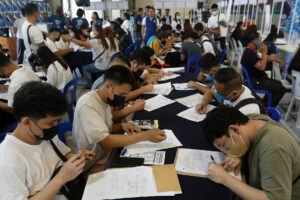




Inflation Update: Green light for easing
 DOWNLOAD
DOWNLOAD

December Economic Update: One for them, one for us
 DOWNLOAD
DOWNLOAD

Philippines Trade Update: Trade trajectories trend along
 DOWNLOAD
DOWNLOAD


Jobless rate hits 4-month high in January

THE UNEMPLOYMENT RATE rose to a four-month high of 4.8% in January amid the loss of temporary holiday jobs, the Philippine Statistics Authority (PSA) said on Thursday.
Preliminary data from the PSA’s Labor Force Survey (LFS) showed the jobless rate went up to 4.8% in January, from 4.3% in December. It is the highest jobless rate since the 5% recorded in September.
This is equivalent to 2.37 million jobless Filipinos in January, higher than 2.22 million in December.
Year on year, the unemployment rate dropped from 6.4%, equivalent to 2.95 million, in January 2022.
PSA Undersecretary and National Statistician Claire Dennis S. Mapa said they had expected unemployment numbers to rise month on month in January due to the loss of temporary jobs during the holidays.
“There is some seasonality, although we have seen the source of (higher year-on-year) unemployment was construction,” he said during an online briefing in mixed English and Filipino.
Job quality worsened in January, as the underemployment rate jumped to 14.1%, from 12.6% in December. This translated to 6.65 million underemployed Filipinos or persons already working but still looking for more work or longer working hours, versus the 6.197 million in December.
Year on year, the underemployment rate improved from 14.9% in January 2022.
Despite the slight uptick in joblessness, the National Economic and Development Authority (NEDA) said the latest numbers showed the labor market’s “robust” recovery from a year earlier when a surge in coronavirus cases hit the country.
“However, we note that employment created year on year was mostly part-time and classified as vulnerable,” NEDA Secretary Arsenio M. Balisacan said in a statement.
“Thus, it is imperative that labor market policies and programs that directly contribute to labor productivity and employment generation must be prioritized, not only to preserve jobs but also to generate quality jobs.”
PSA’s Mr. Mapa said the employment rate would likely hover near the 4% to 5% level in the next few months.
“We see the unemployment trend to go back to pre-pandemic levels this year since it started this October and the second half of 2022,” he said.
Weak jobs market?
In January, the size of the total labor force fell to 49.72 million, from 51.22 million in December.
This brought the labor force participation rate (LFPR) — the share of the Filipino workforce to the total working age population of 15 years old and over — to 64.5% in January, slightly lower than the 66.4% in December.
The employment rate dipped to 95.2% in January, from 95.7% in December. However, it was higher than 93.6% in the same month in 2022.
This means 47.35 million Filipinos had jobs in January, lower than the 49 million in December.
On average, an employed Filipino worked 39.5 hours a week in January compared with 40.3 hours logged in December and 41.8 hours in January last year.
The services sector remained the top employer in January with an employment rate of 60.7% followed by agriculture at 22.2% and industry at 17.1%
Month on month, higher employment was seen in human health and social work activities (up 185,000); transportation and storage (up 182,000); real estate activities (up 93,000); and professional, scientific and technical activities (up 79,000).
Meanwhile, job losses in January were seen in agriculture and forestry (down 1.113 million); wholesale and retail trade, repair of motor vehicles and motor vehicles and motorcycles (down 375,000); and construction (down 288,000).
Year on year, construction had the biggest drop in employment at 334,000, followed by water supply and sewerage at 34,000.
“The jobs market looks to be weakening as manufacturing and construction jobs will likely decline in the coming months,” China Banking Corp. Chief Economist Domini S. Velasquez said in a Viber message, citing the S&P Global Philippines’ latest Purchasing Managers’ Index (PMI) report.
“On a positive note, jobs in the services sector will do the heavy lifting due to the increase in tourism activities and flexible work arrangements of the business process outsourcing industry,” she added.
Jose G. Matula, president of the Federation of Free Workers, said the government should implement a more robust public employment program.
“While the increase in unemployment could be partly due to the lack of holiday jobs during the festive season, the rise in underemployment indicates that even those with jobs struggle to find sufficient work to make ends meet,” he said in a Viber message.
Mr. Matula, who heads the largest labor coalition in the country, also called for a P100 billion stimulus package for micro, small, and medium enterprises to cope with rising prices of basic commodities.
PSA data showed that wage and salary earners made up 62.3% of the workforce in January.
Inflation slowed to 8.6% in February from 8.7% in January, but core inflation accelerated to 7.8%, its fastest pace in over 22 years.
ING Bank N.V. Manila Senior Economist Nicholas Antonio T. Mapa said the rise in unemployment and underemployment reflects the “scarring effects” and challenges faced by the economy.
“Lower job creation amidst the cost of living crisis (not to mention surging borrowing costs) only highlights the factors that could force overall growth to slow this year,” he said in a Viber message.
ING’s Mr. Mapa said recent data makes it likely that the Bangko Sentral ng Pilipinas (BSP) will raise interest rates by 25 basis points (bps) at its meeting this month, as “monetary tightening will need to run its course while BSP remains cognizant of the slowing growth momentum of the economy.”
The BSP has raised rates by 400 basis points (bps) since May 2022, bringing the policy rate to 6%, the highest since 2007.
The Monetary Board’s next meeting is on March 23. — By John Victor D. Ordoñez, Reporter
This article originally appeared on bworldonline.com





 By BusinessWorld
By BusinessWorld
